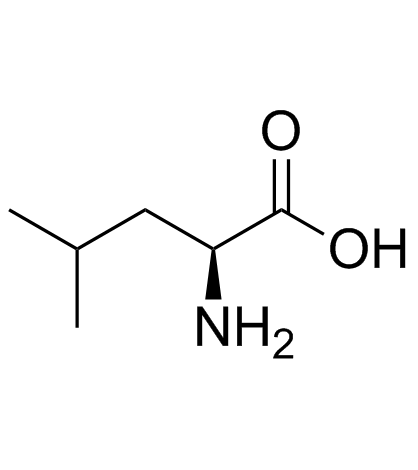L-leucine

L-leucine structure
|
Common Name | L-leucine | ||
|---|---|---|---|---|
| CAS Number | 61-90-5 | Molecular Weight | 131.173 | |
| Density | 1.0±0.1 g/cm3 | Boiling Point | 225.8±23.0 °C at 760 mmHg | |
| Molecular Formula | C6H13NO2 | Melting Point | 286-288 ºC | |
| MSDS | Chinese USA | Flash Point | 90.3±22.6 °C | |
|
Activation of Tomato Bushy Stunt Virus RNA-Dependent RNA Polymerase by Cellular Heat Shock Protein 70 Is Enhanced by Phospholipids In Vitro.
J. Virol. 89(10) , 5714-23, (2015) Similar to other positive-strand RNA viruses, tombusviruses are replicated by the membrane-bound viral replicase complex (VRC). The VRC consists of the p92 virus-coded RNA-dependent RNA polymerase (RdRp), the viral p33 RNA chaperone, and several co-opted host... |
|
|
Pregnancy and lactation alter biomarkers of biotin metabolism in women consuming a controlled diet.
J. Nutr. 144(12) , 1977-84, (2014) Biotin functions as a cofactor for several carboxylase enzymes with key roles in metabolism. At present, the dietary requirement for biotin is unknown and intake recommendations are provided as Adequate Intakes (AIs). The biotin AI for adults and pregnant wom... |
|
|
Improved characterization of EV preparations based on protein to lipid ratio and lipid properties.
PLoS ONE 10(3) , e0121184, (2015) In recent years the study of extracellular vesicles has gathered much scientific and clinical interest. As the field is expanding, it is becoming clear that better methods for characterization and quantification of extracellular vesicles as well as better sta... |
|
|
BoHV-4 immediate early 1 gene is a dispensable gene and its product is not a bone marrow stromal cell antigen 2 counteracting factor.
BMC Vet. Res. 11 , 224, (2015) Bovine herpesvirus 4 (BoHV-4) is a gammaherpesvirus whose genome was cloned as Bacterial Artificial Chromosome (BAC) and exploited as a gene delivery vector for vaccine purposes. Although BoHV-4 genome has been completely sequenced and its open reading frames... |
|
|
Anthocyanins and antioxidant capacities of six Chilean berries by HPLC-HR-ESI-ToF-MS.
Food Chem. 176 , 106-14, (2015) The HPLC profiles of six fruits endemic of the VIII region of Chile were investigated using high resolution mass analysis (HR-ToF-ESI-MS). The anthocyanin fingerprints generated for the fruits were compared and the antioxidant capacities measured by the scave... |
|
|
General unknown screening for pesticides in whole blood and Korean gastric contents by liquid chromatography-tandem mass spectrometry.
Arch. Pharm. Res. 37(10) , 1317-24, (2014) A method of simultaneously screening 215 types of pesticides has been established by liquid chromatography with tandem mass spectrometry, quadrupole/time of flight mass spectrometry and triple quadrupole mass spectrometry. Samples of blood and gastric content... |
|
|
Discovery and characterization of a novel class of pyrazolopyrimidinedione tRNA synthesis inhibitors.
J. Antibiot. 68 , 361-7, (2015) A high-throughput phenotypic screen for novel antibacterial agents led to the discovery of a novel pyrazolopyrimidinedione, PPD-1, with preferential activity against methicillin-resistant Staphylococcus aureus (MRSA). Resistance mapping revealed the likely ta... |
|
|
Use of Commercial Dry Yeast Products Rich in Mannoproteins for White and Rosé Sparkling Wine Elaboration.
J. Agric. Food Chem. 63 , 5670-81, (2015) In sparkling wines, mannoproteins released during yeast autolysis largely affect their final quality. This process is very slow and may take several months. The aim of this work was to study the effect of several commercial dry yeast autolysates on the chemic... |
|
|
The human serum metabolome.
PLoS ONE 6(2) , e16957, (2011) Continuing improvements in analytical technology along with an increased interest in performing comprehensive, quantitative metabolic profiling, is leading to increased interest pressures within the metabolomics community to develop centralized metabolite ref... |
|
|
Brain amino acid requirements and toxicity: the example of leucine.
J. Nutr. 135(6 Suppl) , 1531S-8S, (2005) Glutamic acid is an important excitatory neurotransmitter of the brain. Two key goals of brain amino acid handling are to maintain a very low intrasynaptic concentration of glutamic acid and also to provide the system with precursors from which to synthesize ... |